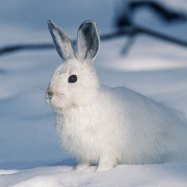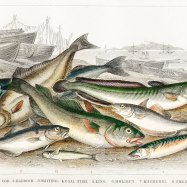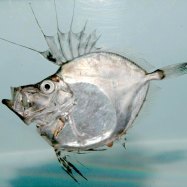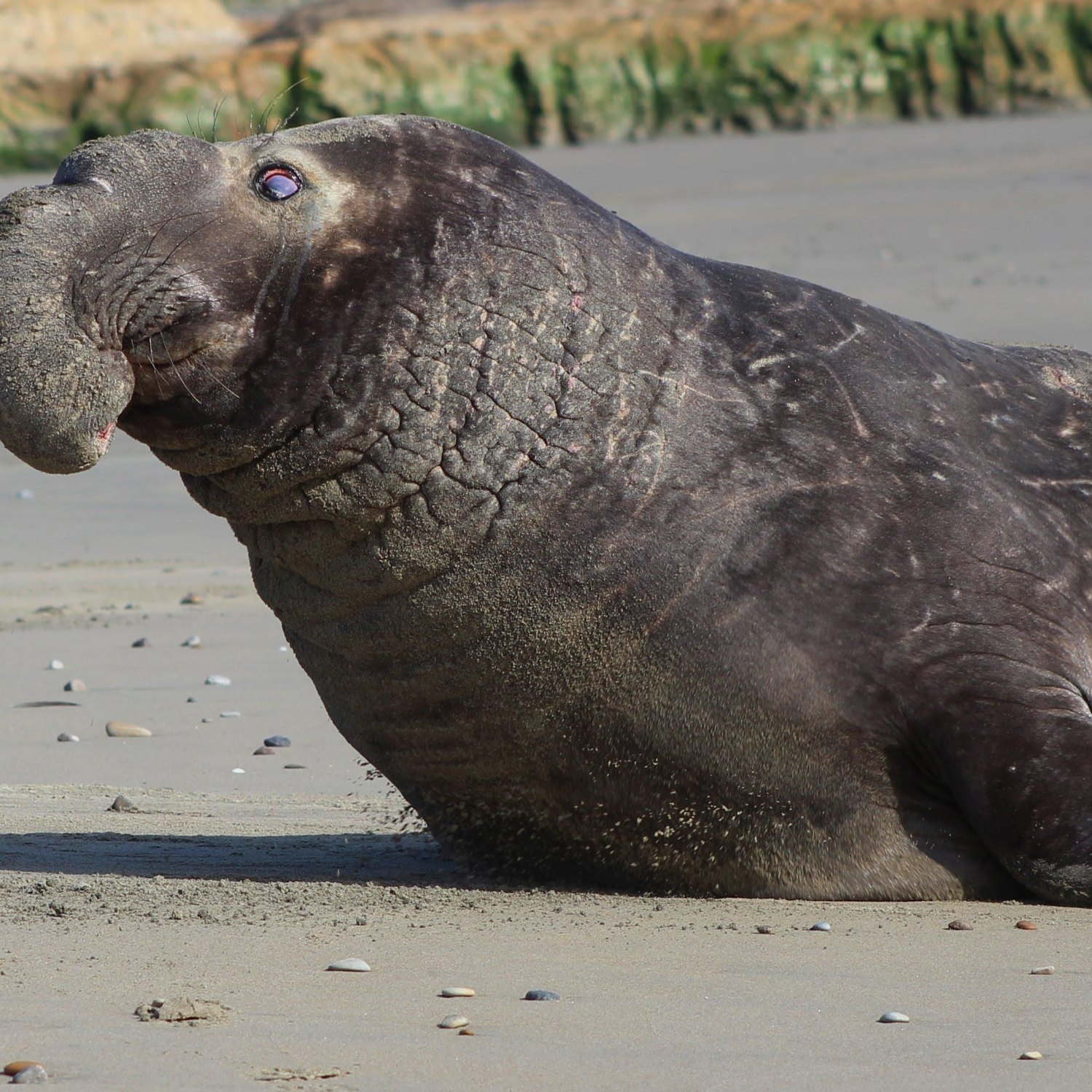
Elephant Seal
Male: up to 20 feet; Female: up to 10 feet
The Elephant Seal, a member of the Phocidae family, is a massive marine mammal found in coastal areas. The males can reach up to 20 feet in length while females can grow up to 10 feet. Their robust and cylindrical bodies make them powerful swimmers, and they are known for their unique vocalizations. These fascinating animals are a must-see for any wildlife enthusiast.
Animal Details Summary:
Common Name: Elephant Seal
Kingdom: Animalia
Habitat: Coastal regions and islands
The Majestic Elephant Seal: A Fascinating Creature of the Coast
The ocean is home to a diverse range of creatures, each with its own unique characteristics and adaptations. Among the most captivating of these creatures is the elephant seal, a massive and majestic animal that roams the coastal regions and islands of the world.Scientifically known as Mirounga, the elephant seal belongs to the Animalia kingdom, Chordata phylum, Mammalia class, and Carnivora order. It is part of the Phocidae family, along with other seal species Elephant Seal. Its name is derived from its characteristic large size and its trunk-like nose, resembling that of an elephant.
With its sheer size and imposing figure, the elephant seal may seem intimidating at first, but a closer look at this fascinating creature will reveal a gentle and fascinating animal that is not only a vital part of its ecosystem, but also a symbol of strength and resilience.
The Habitat of the Elephant Seal
The elephant seal is primarily found in coastal regions and islands, making its home in various locations around the world. Its geographical distribution includes Antarctica, sub-Antarctic islands, California, and the Pacific coast of Mexico. This wide range allows the elephant seal to adapt to various environments, including extreme weather conditions and diverse food sources.A Carnivorous Appetite
As a member of the Carnivora order, it is no surprise that the elephant seal is a carnivore. It primarily feeds on fish, squid, crustaceans, and other marine creatures, relying on its strong and sharp teeth to catch and consume its prey. Due to their large size, elephant seals require a substantial amount of food to maintain their body mass and energy levels. They are known to consume up to 8% of their body weight in a single day Elk.Despite their intimidating appearance and their carnivorous nature, elephant seals are vital to the balance of the marine ecosystem. Research has shown that their feeding habits help maintain the population of certain fish and squid species, preventing over-predation and promoting biodiversity.
The Life of an Elephant Seal
The life of an elephant seal follows a unique and fascinating pattern, starting with their breeding cycle. Every year, between the months of December and March, male elephant seals gather on beaches to compete for a harem of females. These intense battles can result in severe injuries, but the strongest and most dominant males earn the right to mate with multiple females.Female elephant seals give birth to a single pup, which they nurse for about a month while fasting themselves. During this time, the mothers and their pups form a strong bond, communicating through vocalizations and touch. After the nursing period, the pups are weaned and left to fend for themselves on the beach until they are ready to enter the ocean.
Male elephant seals can grow up to 20 feet in length and weigh up to 8,800 pounds, making them one of the largest marine mammals in the world. Female elephant seals, on the other hand, are only about half the size of males, measuring up to 10 feet and weighing up to 1,700 pounds. Despite their significant size difference, both male and female elephant seals are equally impressive and essential to their ecosystem.
The lifespan of an elephant seal is about 9 to 10 years in males and 12 to 13 years in females. However, some individuals have been known to live up to 20 years in the wild.
The Appearance of the Elephant Seal
The elephant seal's appearance is distinct and easily recognizable, with its robust and cylindrical body shape, large flippers, and distinctive trunk-like nose. Its head and neck are covered in thick blubber, giving it a round and smooth appearance, while its body is coated in a layer of dark brown to light gray fur. The coloration of the elephant seal's fur is essential for insulation, as it helps regulate their body temperature and protects them from the harsh coastal winds.Elephant seals have a unique molting process, where they shed their skin and fur twice a year. This helps them maintain their waterproof layer and keep their fur clean and healthy.
The Importance of Conservation
Despite their impressive size and the vital role they play in the marine ecosystem, elephant seals were historically hunted and killed for their blubber, meat, and fur. This led to a significant decline in their population, and they were listed as an endangered species in the late 19th century.Thanks to conservation efforts and strict regulations on hunting, the population of elephant seals has slowly recovered. However, they still face threats from human activities and pollution, which can harm their habitat and food sources. Therefore, it is crucial to continue to protect and preserve these magnificent creatures for future generations to see and appreciate.
The Future of the Elephant Seal
The future of the elephant seal is dependent on the actions we take today. As a species that is highly adapted to its environment and plays a significant role in the marine ecosystem, losing the elephant seal would have a detrimental effect on the balance of the ocean.Fortunately, with increased awareness and conservation efforts, the elephant seal population has been making a slow but steady recovery. More and more people are becoming aware of the importance of preserving our natural world, and organizations and governments are implementing regulations and measures to protect endangered species.
By taking steps to reduce pollution, limit human interference in their habitats, and promote sustainable fishing practices, we can ensure the survival and well-being of the magnificent elephant seal for years to come.
A Fascinating Creature of Strength and Beauty
In conclusion, the elephant seal is a truly remarkable creature, both in its appearance and its role in the natural world. Its imposing size and distinct features make it a captivating sight, while its adaptability and resilience make it a symbol of strength and perseverance.As we continue to learn more about these majestic animals, it becomes clear that their survival is intertwined with our own. By taking steps towards conservation and preserving their natural habitats, we can ensure that the majestic elephant seal remains a vital part of the coastal regions and islands for generations to come. Let us cherish and protect these magnificent creatures and appreciate their beauty and significance in our world.

Elephant Seal
Animal Details Elephant Seal - Scientific Name: Mirounga
- Category: Animals E
- Scientific Name: Mirounga
- Common Name: Elephant Seal
- Kingdom: Animalia
- Phylum: Chordata
- Class: Mammalia
- Order: Carnivora
- Family: Phocidae
- Habitat: Coastal regions and islands
- Feeding Method: Carnivorous
- Geographical Distribution: Antarctica, sub-Antarctic islands, California, and the Pacific coast of Mexico
- Country of Origin: Various
- Location: Coastal areas
- Animal Coloration: Dark brown to light gray
- Body Shape: Robust and cylindrical
- Length: Male: up to 20 feet; Female: up to 10 feet
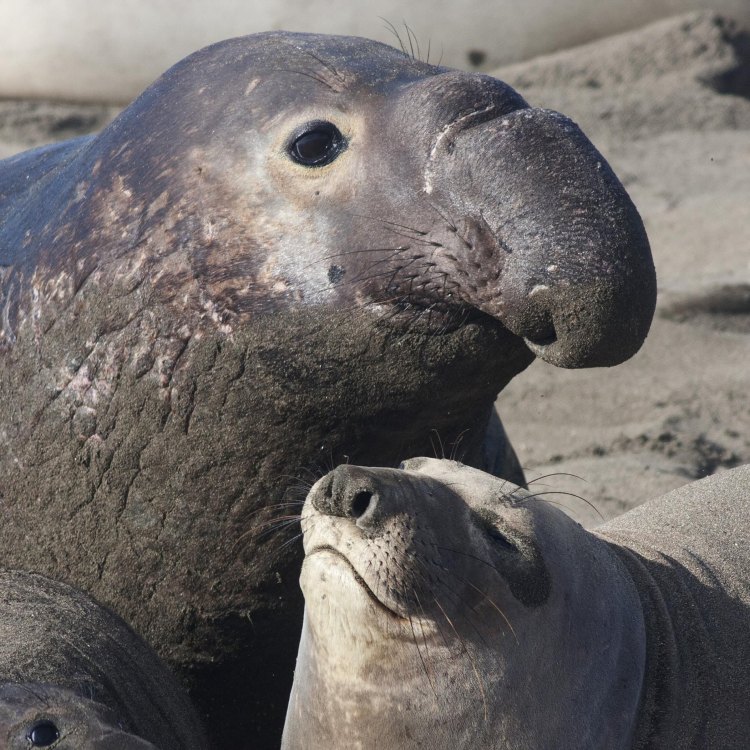
Elephant Seal
- Adult Size: Male: 4,500 to 6,000 kilograms; Female: 500 to 800 kilograms
- Average Lifespan: 20 to 22 years
- Reproduction: Sexual
- Reproductive Behavior: Polygynous
- Sound or Call: Loud roars and deep barks
- Migration Pattern: Seasonal migration
- Social Groups: Colonial breeders
- Behavior: Solitary except during breeding season
- Threats: Overfishing, pollution, climate change
- Conservation Status: Least Concern
- Impact on Ecosystem: Regulate prey populations
- Human Use: Harvested for oil in the past
- Distinctive Features: Large size, trunk-like nose, thick blubber layer
- Interesting Facts: Elephant seals are the largest pinnipeds and the males have an inflatable, trunk-like nose.
- Predator: Sharks, killer whales
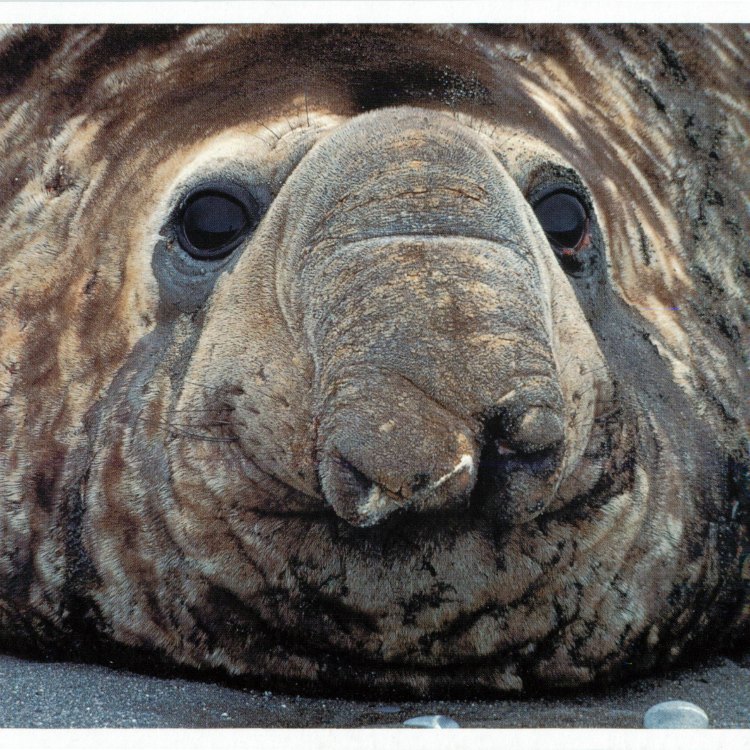
Mirounga
The Mighty Giants of the Sea: The Fascinating World of Elephant Seals
When one imagines seals, the image of a sleek, small creature basking on a rock may come to mind. However, there is one species of seal that defies this stereotype and stands out among its counterparts for its giant size and unique features - the elephant seal.Found in the sub-Antarctic and temperate waters of the Southern Hemisphere, the elephant seal is the largest seal species and one of the largest marine mammals in the world. Despite its name, elephants seals are not related to elephants in any way PeaceOfAnimals.Com. They get their name from the large, inflatable nose of the male, which resembles an elephant's trunk.
Let's dive deeper into the fascinating world of elephant seals and discover what makes them such a unique and interesting species.
The Size and Lifespan of the Elephant Seal
Adult male elephant seals can reach staggering sizes, weighing between 4,500 to 6,000 kilograms, and measuring up to six meters in length. This makes them larger than any other seal species and second only to the Southern elephant seal, which can weigh up to 5,000 kilograms but is longer in length.The females, on the other hand, are significantly smaller, with an average weight of 500 to 800 kilograms and a length of around three meters. Despite their size difference, both males and females have a similar lifespan of around 20 to 22 years in the wild.
The size difference between male and female elephant seals is due to a phenomenon called sexual dimorphism. This means that the males and females of a species have distinct physical differences, primarily related to reproductive behavior.
Reproduction and Reproductive Behavior
Elephant seals are sexually reproducing animals, with a polygynous mating system Egret. This means that one male competes with others to mate with multiple females during breeding season. In elephant seals, the breeding season occurs between December to March, also known as the southern hemisphere summer.During this time, the males fight for dominance through loud roars and deep barks. The victorious male then creates a harem, consisting of up to 100 females, which he will mate with. The other males are left to fend for themselves and find their own females to mate with.
After a successful mating season, the female elephant seals will give birth around 11 months later, in the following breeding season. Elephant seals practice delayed implantation, which means that the fertilized egg does not implant in the uterus right away. Instead, it remains dormant for several months, ensuring that the pup is born during the optimal time for survival.
Sound and Call
Elephant seals are known for their loud and distinctive calls, which have been recorded to reach levels of up to 116 decibels - as loud as a chainsaw! The calls are used primarily during breeding season to establish dominance and attract females.Aside from loud roars and deep barks, elephant seals also use body language to communicate, such as head gestures, throat inflation, and posturing. It is believed that each individual seal has a unique call, allowing them to communicate and recognize each other within their colonies.
Migration Pattern and Social Groups
Elephant seals are best known for their epic migrations, traveling thousands of kilometers every year in search of food and breeding grounds. They have a seasonal migration pattern, where they move from their feeding grounds near the Antarctic waters to breeding grounds on beaches in South America and remote islands in the Southern Hemisphere.The males and females have different migration patterns due to their distinct roles during breeding season. The males travel further distances to reach the breeding grounds, while the females stay relatively closer to their feeding grounds.
Elephant seals are colonial breeders, meaning they gather in large groups to breed and give birth. The breeding groups, or colonies, can consist of thousands of seals, creating a noisy and bustling environment during breeding season.
Behavior and Threats
Aside from their social behavior during breeding season, elephant seals are usually solitary animals. They spend most of their time in the water, diving to deep depths to feed on various fish and squid species.Unfortunately, elephant seals, like many other marine animals, face many threats in their environment. Overfishing, pollution, and climate change have all had a negative impact on their populations.
The depletion of prey species due to overfishing has forced elephant seals to travel further and dive longer to find food, resulting in increased energy expenditure and potential starvation. Pollution, such as oil spills, can also harm elephant seals by contaminating their habitat and food sources.
Climate change has also affected the migration patterns and breeding success of elephant seals. Changing ocean temperatures and currents can alter the distribution of prey species, making it harder for the seals to find food. It can also disrupt the timing of breeding season and the delayed implantation process, leading to lower pup survival rates.
Conservation Status and Ecosystem Impact
Despite these threats, the overall population of elephant seals is considered to be of "Least Concern" by the International Union for Conservation of Nature (IUCN). Thanks to conservation efforts and regulations put in place to protect them, elephant seals have made a remarkable recovery since the decline in the early 20th century.In addition to its cultural and ecological value, elephant seals play a crucial role in regulating prey populations in their ecosystem. As top predators, they help to maintain balance within the food chain, ensuring the health of their environment.
Human Use and Interesting Facts
Elephant seals have been an important resource for humans in the past. They were hunted for their oil in the 18th and 19th centuries, which was used for various purposes, such as lighting and lubrication. However, since the decline in their populations, elephant seals have been protected by law, and hunting them is now illegal.Aside from their notable size and distinctive nose, there are many other interesting facts about elephant seals. Did you know that they can hold their breath for up to two hours and dive as deep as 3,000 meters? That's deeper than most submarines can go! They also have the thickest blubber layer of any mammal, up to four inches, which helps them to stay warm in the cold Antarctic waters.
Predators
As intimidating as they may seem, elephant seals do have predators in the ocean. Their top predators include sharks and killer whales, which mainly prey on the young and weak individuals. However, the sheer size and strength of adult elephant seals make them less vulnerable to attacks from these predators.In Conclusion
The world of elephant seals is full of fascinating facts and unique features that set them apart from other seal species. From their giant size to their seasonal migrations and loud calls, these mighty giants play an essential role in their ecosystem, and their conservation is crucial for the health of our oceans.Despite facing various threats, elephant seals have shown resilience and have made a remarkable recovery, thanks to conservation efforts. As we continue to learn more about these magnificent creatures, let us also strive to protect them and ensure their survival for generations to come.
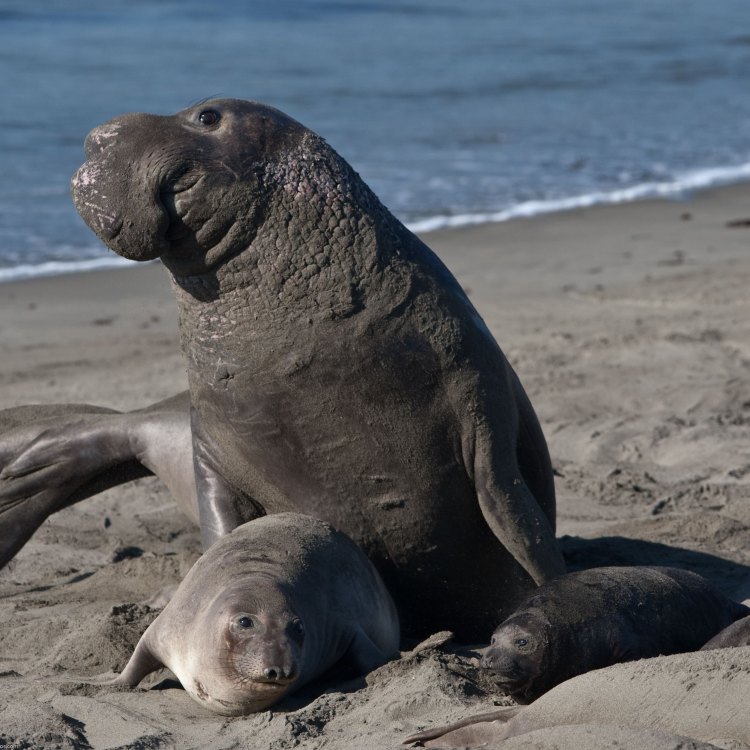
The Majestic Elephant Seal: A Fascinating Creature of the Coast
Disclaimer: The content provided is for informational purposes only. We cannot guarantee the accuracy of the information on this page 100%. All information provided here may change without prior notice.





